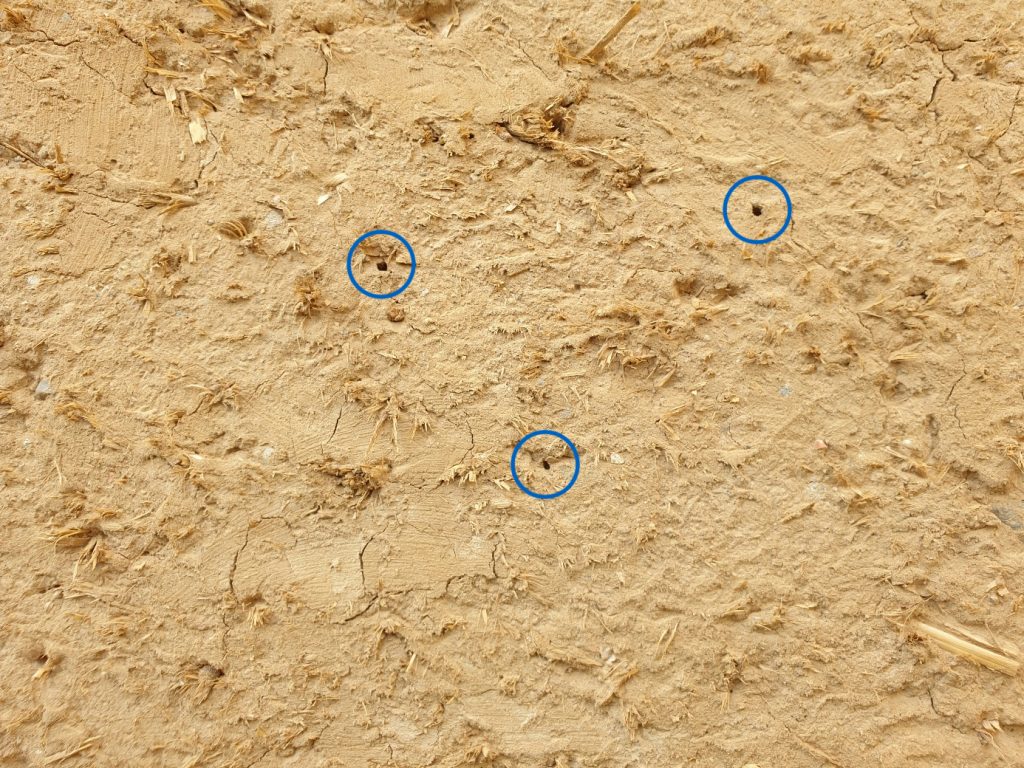Cob
Cob building is a historical, originally rural, shuttering-free construction method. This technique has become widespread all over Europe in areas with local clay deposits. Traditionally, cob (loam reinforced with straw) is laid down manually in layers. The layers are left to set for a few days. Afterwards, they are manually reworked and straightened by cutting them with a sharp spade.
Cob, which was displaced by concrete in the 20th century, can be shaped into any form for vertical structures – similar to concrete. It is self-supporting and erosion-resistant without plaster.
Cob technology
The cob building method has a high innovation potential. Together with an international research team, we work on an industrially usable process to help Wellerlehm achieve a breakthrough as a building material for load-bearing walls. Key to this are the logistical improvements achieved through prefabrication.
Pilot tests with a cob clay press prototype on a scale of 1:4 have shown that significantly higher densities of the hardened cob clay can be achieved; in addition, the range of applications can be varied from insulation to lightweight construction to load-bearing walls by using different clay-to-vegetable fibre ratios.
Mechanical engineering: Kay Hoffmann, Laaslich
Construction: Michael Schmiel
Equipment: Steffen Schmelzer, Wittenberge
Material: Henry Krüger, Perleberg
Material Thuringia: Thomas Stulier, Langensalza
Idea for the technology: Martin Rauch, Schlins
Pre-tests: Nils Kohlhase, Mohamad Saleh, Lübeck
Initial idea: Ute Reeh, Düsseldorf, Nebelin
Our concept of establishing cob as a modern and forward-looking building material combines immense economic and ecological advantages:
- Recycling capability
Unlike concrete, clay can simply be levelled on site in the event of deconstruction or reused for the next building project. Since it does not require any stabilising additives, it is 100% recyclable. - Durability
Furthermore, earthen buildings have a much longer lifespan (hundreds of years) than conventional buildings. In the second pilot test with the cob press prototype, recycled cob clay that came from a building of 1711 in Thuringia was used. In measurements, it even showed a higher strength than blocks pressed from Prignitz clay. - Economy
Our process achieves a high compressive strength. It enables the construction of load-bearing walls from excavated soil taken directly from the site and mixed with straw. This can be compacted according to our recipe. We are thus opening up a construction method whose material is available (almost) everywhere and can be implemented on a large scale in the future. - Indoor climate
Solid earth buildings, as in the case of cob, are unrivalled in their ability to regulate humidity and heat in their
regulating the indoor climate and comfort. - CO2 neutrality
Our concept is to work with local loam, i.e. with excavated soil and straw from the respective region. Consequently, only little energy is required for the production and use of the building material – unlike aluminium or concrete, for example, whose production and transport over long distances consumes a lot of energy. Cob also has a favourable carbon footprint irrespective of its production, as the high proportion of straw (or other plant fibres) in it binds carbon that these plants have removed from the atmosphere in the form of CO2. - Nature conservation
Wellerlehm provides shelter for particularly protected wild bee species.
Figure: Test wall in Nebelin, it has already been colonised by wild bees some weeks after its realisation. Photo Dr Dieter Günnewig, July 2020.

